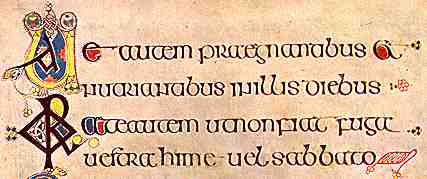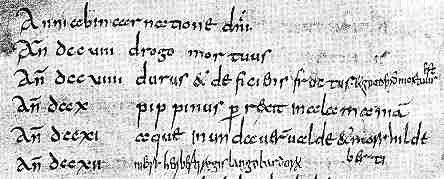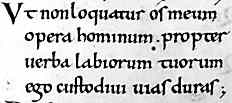




If you are looking at this page without frames, there is more information about medieval writing to be found by going to the home page (framed) or the site map (no frames).
| Why Paleography Sucks (4) | ||
| The minuscule book hands in use in pre-Carolingian western Europe have been labelled the National Hands. This is a stupid name. They do not represent developing national identity as expressed in handwriting. Rather, they are the product of little islands of literacy in a largely illiterate world. The early medieval church had its own literate culture and systems of communication which formed nodes of literate practice and corridors of influence that transcended national identities. The turbulent events of the times caused these patterns to churn and styles of writing to interact. Simple classification of these scripts can be problematic. | ||
| The insular sytem of scripts, as used in Britain before the Norman Conquest and in Ireland until much later, is the only one of these categories that has been dissected into a hierarchy of scripts. From the grand insular half uncial, the system proceeds in decreasing formality through hybrid minuscule, set minuscule, cursive minuscule and current minuscule. Anglo-Saxon minuscule, as used in England, is seen as having chronological phases going from pointed through square to round (Roberts 2005, Brown 1990). This is not too complicated. | ||
 |
Insular half uncial from the Book of Kells, f.104r. | |
 |
||
| Segment from a page of an 8th century martyrology written in insular minuscule script (Paris. Bibliothèque Nationale, MS Lat. 10837, f.8). (From New Palaeographical Society 1910) | ||
| Insular scripts are readily identifiable and able to be categorised, as they were part of a long lived system existing in some degree of isolation, far to the west of everywhere. They developed their own graphic style, rules and hierarchy. They travelled to some parts of Europe with communities of monks, where they are readily recognised. They survived in Ireland until very late, and travelled to Scandinavia, which is even further from everywhere. | ||
| Two other families from the fringes, which were also long lived, Visigothic and Beneventan minuscule, are also fairly easily identified and categorised. It is in the middle of western Europe, with all that was going on there, that the classification system gets seriously messy. | ||
| The term Lombardic minuscule has been ascribed to early book hands in Italy. The Lombards were barbarian invaders of northern Italy, probably largely illiterate in the early days, and never really developing a literate culture (Petrucci 1995). Funny people to name a script after. Edmund Maunde Thompson (Thompson 1912) claims that the defeat of the Lombards in northern Italy by Charlemagne caused the writing style to be subject to other influences in that area, and that the term Lombardic should only be applied to the precursors of the Beneventan script in the south of Italy. So why not call it early Beneventan or pre-Beneventan? Bischoff (Bischoff 1990) asserts that the scripts of northern Italy had no particularly distinguishing characteristics, such as would put them in a special category. | ||
 |
||
| The example comes from a 7th century copy of the Homilies of St Maximus of Turin (Milan, Biblioteca Ambrosiana, C.98, parte inferiore, f.89). (From Steffens 1929) | ||
| Steffens designates the example above as an old northern Italian book hand. He does not use the term Lombardic. Among all the assorted reproductions of paleographical samples at my disposal, I have only come across one ascribed to Lombardic that was not a pre-Beneventan script. The attribution was later corrected to Corbie ab, which is a different creature altogether. So much for Lombardic. Off with its head! | ||
| The term Merovingian minuscule has been used for the early book hands of the Frankish Empire, but this is a very strange box of tricks. Thompson (Thompson 1912) used the term in a restricted sense, for scripts that were very closely related to Merovingian chancery script, as used for formal royal diplomas. This has since been labelled Luxeuil minuscule, a specific subset of the Merovingian family with a strong association with a particular monastery and writing centre. The script called Corbie ab has similar status as a subset. He used the term Franco-Lombardic as a general descriptor for Merovingian scripts that didn't look as Merovingian as all that. The term pre-Carolingian was used for scripts produced by scribes who went back to some uncial and half uncial forms in order to produce something more elegant and legible. The term Germanic minuscule has been used by others to designate such scripts that were anticipating the Carolingian reforms. Perhaps a reasonable working rule might be that if you can read it, it's Germanic; if you can't read it, it's Merovingian. | ||
 |
Sample from annals of 791 from the abbey of Lorsch (Vatican Library, Palat. 966, f.53v). (From Ehrle and Libaert 1932) | |
| The above example is described as being in Germanic minuscule with additions in Merovingian minuscule, which can be seen at the end of the third line and in the bottom line of this picture. See what I mean? | ||
| Bernhard Bischoff (Bischoff 1990, 1994) has approached the pre-Carolingian scripts from a different perspective, examining the historical processes that have led to patterning in writing styles, rather than using a classificatory model. He has examined and clarified where writing centres have flourished, developing their own particular styles, and where they have been mixed and dispersed by unruly events of the era; conquest and missionising, Saracen invasions, Viking incursions and the like. While it is an intricate and fascinating study, it contains a level of detail that would be very very difficult to sustain in dealing with the much greater volume of material of the later middle ages. His approach does show the limitations of mere classification when placed alongside historical analysis. | ||
| The development of Caroline minuscule could definitely be described as an event, albeit one which did not happen abruptly. It is not an artifact of classification. Scribes all over western Europe were writing, if not all exactly the same, at least in a clear and consistent way was that was mutually comprehensible. And we can read it too. The world has stopped going crazy and has worked out that writing is supposed to be so that we can all communicate with each other. | ||
 |
This sample of text comes from the early 11th century Harley Psalter (British Library, Harley 603), by permission of the British Library. | |
| See, how easy is that? | ||
| The transition from Caroline minuscule to Gothic may have originated in the simple act of scribes trying to get more bang for their buck by squashing more words into a line. It also coincided with a period of steadily increasing use of writing for a whole range of purposes. Bureaucracies were generating more stuff, and people at various levels of society were owning more books. Scripts galloped off into another period of wild divergence, with style variations between geographical areas and for different purposes. For this era, the many attempts to classify scripts become more and more complicated and employ more obscure vocabulary. And they don't necessarily fit together. | ||
If you are looking at this page without frames, there is more information about medieval writing to be found by going to the home page (framed) or the site map (no frames). |
||